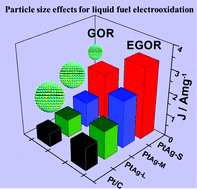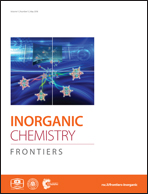Particle size effects of PtAg nanoparticles on the catalytic electrooxidation of liquid fuels†
Abstract
A tailored design of highly efficient Pt-based bimetallic nanocatalysts for the electrooxidation of liquid fuel offers a promising approach for the commercialization of fuel cells. Although extensive researches on seeking high-performance Pt-based nanocrystals for electrocatalytic reactions have been conducted, the particle size effects of bimetallic Pt-based nanoparticles (NPs) on the fuel cell reaction remain unclear. In this regard, we herein report a size-controlled synthesis of bimetallic Pt–Ag NPs. By varying the amount of phloroglucinol involved in the reaction, Pt–Ag NPs with variable sizes from 7.5 to 15.0 nm can be prepared. By virtue of the unique particle size effects, abundant active sites on the surface as well as the synergistic and electronic effects due to Pt and Ag, these Pt–Ag NPs with the smallest particle size exhibit the best electrocatalytic activities for ethylene glycol and glycol oxidation reactions, and the electrocatalytic activities of Pt–Ag NPs are as much as 3.1 and 3.4 times higher when compared with those of the commercial Pt/C catalysts. This research can provide significant guidelines for the size selection of bimetallic Pt-based nanocatalysts with both enhanced activity and durability for fuel cell reactions.



 Please wait while we load your content...
Please wait while we load your content...